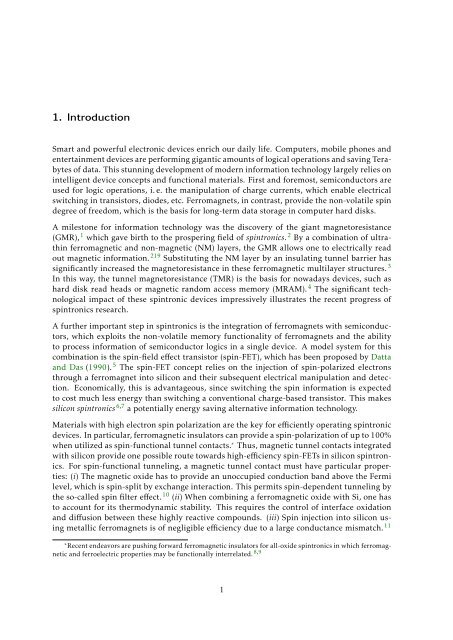Text anzeigen (PDF) - Universität Duisburg-Essen
Text anzeigen (PDF) - Universität Duisburg-Essen
Text anzeigen (PDF) - Universität Duisburg-Essen
You also want an ePaper? Increase the reach of your titles
YUMPU automatically turns print PDFs into web optimized ePapers that Google loves.
1. Introduction<br />
Smart and powerful electronic devices enrich our daily life. Computers, mobile phones and<br />
entertainment devices are performing gigantic amounts of logical operations and saving Terabytes<br />
of data. This stunning development of modern information technology largely relies on<br />
intelligent device concepts and functional materials. First and foremost, semiconductors are<br />
used for logic operations, i. e. the manipulation of charge currents, which enable electrical<br />
switching in transistors, diodes, etc. Ferromagnets, in contrast, provide the non-volatile spin<br />
degree of freedom, which is the basis for long-term data storage in computer hard disks.<br />
A milestone for information technology was the discovery of the giant magnetoresistance<br />
(GMR), 1 which gave birth to the prospering field of spintronics. 2 By a combination of ultrathin<br />
ferromagnetic and non-magnetic (NM) layers, the GMR allows one to electrically read<br />
out magnetic information. 219 Substituting the NM layer by an insulating tunnel barrier has<br />
significantly increased the magnetoresistance in these ferromagnetic multilayer structures. 3<br />
In this way, the tunnel magnetoresistance (TMR) is the basis for nowadays devices, such as<br />
hard disk read heads or magnetic random access memory (MRAM). 4 The significant technological<br />
impact of these spintronic devices impressively illustrates the recent progress of<br />
spintronics research.<br />
A further important step in spintronics is the integration of ferromagnets with semiconductors,<br />
which exploits the non-volatile memory functionality of ferromagnets and the ability<br />
to process information of semiconductor logics in a single device. A model system for this<br />
combination is the spin-field effect transistor (spin-FET), which has been proposed by Datta<br />
and Das (1990). 5 The spin-FET concept relies on the injection of spin-polarized electrons<br />
through a ferromagnet into silicon and their subsequent electrical manipulation and detection.<br />
Economically, this is advantageous, since switching the spin information is expected<br />
to cost much less energy than switching a conventional charge-based transistor. This makes<br />
silicon spintronics 6,7 a potentially energy saving alternative information technology.<br />
Materials with high electron spin polarization are the key for efficiently operating spintronic<br />
devices. In particular, ferromagnetic insulators can provide a spin-polarization of up to 100%<br />
when utilized as spin-functional tunnel contacts. Thus, magnetic tunnel contacts integrated<br />
with silicon provide one possible route towards high-efficiency spin-FETs in silicon spintronics.<br />
For spin-functional tunneling, a magnetic tunnel contact must have particular properties:<br />
(i) The magnetic oxide has to provide an unoccupied conduction band above the Fermi<br />
level, which is spin-split by exchange interaction. This permits spin-dependent tunneling by<br />
the so-called spin filter effect. 10 (ii) When combining a ferromagnetic oxide with Si, one has<br />
to account for its thermodynamic stability. This requires the control of interface oxidation<br />
and diffusion between these highly reactive compounds. (iii) Spin injection into silicon using<br />
metallic ferromagnets is of negligible efficiency due to a large conductance mismatch. 11<br />
Recent endeavors are pushing forward ferromagnetic insulators for all-oxide spintronics in which ferromagnetic<br />
and ferroelectric properties may be functionally interrelated. 8,9<br />
1
















